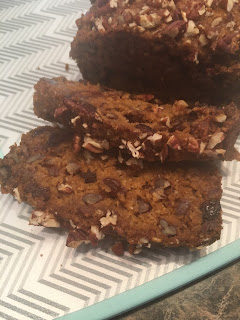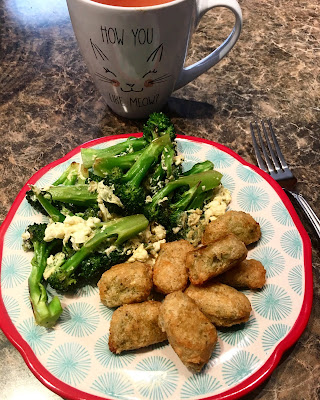Pumpkin, Anyone?
…and of
course: Pumpkin.
I know what you are
thinking…pumpkin is so basic. Yeah, basically delicious! And guess what? Not
only is pumpkin delicious, but it also comes with fun historical facts and
healing nutrition.
Pumpkins are a part of
the Cucurbitaceae family along with gourds and squash. Wait, aren't they all virtually the same thing? Well, they do belong to the same family but have different characteristics.
For one, gourds are ornamental--meaning used for decoration. I remember making bird houses out of gourds in my childhood...we never ate them!
Squash is an edible Cucurbitaceae crop that includes summer, butternut, acorn, and spaghetti varieties. These are great when roasted and pureed, and typically you can find different squash varieties year round.
There are over 45 different varieties of pumpkin that are typically harvested in the fall and can be both ornamental and edible--that is what makes them so unique! We use this fruit to enjoy in fall dishes as well as creative decorations. Did you know that back in the day, the Irish used turnips and potatoes to carve jack-o-lanterns? Weird, right? It was not until Irish immigrants moved to America that they discovered pumpkins were better for carving.
For one, gourds are ornamental--meaning used for decoration. I remember making bird houses out of gourds in my childhood...we never ate them!
Squash is an edible Cucurbitaceae crop that includes summer, butternut, acorn, and spaghetti varieties. These are great when roasted and pureed, and typically you can find different squash varieties year round.
There are over 45 different varieties of pumpkin that are typically harvested in the fall and can be both ornamental and edible--that is what makes them so unique! We use this fruit to enjoy in fall dishes as well as creative decorations. Did you know that back in the day, the Irish used turnips and potatoes to carve jack-o-lanterns? Weird, right? It was not until Irish immigrants moved to America that they discovered pumpkins were better for carving.
Now onto the nutrition! How do
pumpkins benefit our health?
To begin with,
pumpkins are 90% water, meaning they are low in calories and high in fiber. In
one cup of plain and cooked pureed pumpkin, there are 50 calories and 12 grams
of carbohydrate—3 grams from fiber, 2 grams from naturally occurring sugar, and
7 grams of complex carbohydrates.
Micro-nutrients?
Pumpkin is rich in beta-carotene which is the precursor to Vitamin A that helps
us maintain healthy vision, teeth, and skin. One cup of pumpkin provides 87% of
the daily recommendation for Vitamin A.
In addition to
beta-carotene, pumpkin contains vitamin K (for gut health), copper (helps body
form collagen and absorb iron), vitamin C (immunity boost), magnesium (bone
health and calcium absorption), iron (healthy blood), and potassium (protects
muscle mass and preserves bone density).
Whew! That was a mouth
full of how pumpkin can benefit our wellbeing this fall. It isn’t just about
being trendy, but pumpkin has true healing benefits to our bodies, so let’s
incorporate it into our diets this season!
Bonus:
Did you know that pumpkin can be used as an oil replacement in baking? Though
this ingredient is usually the “star” of a baked good, it also serves as a 1:1
ratio to substitute oil. This means that if a recipe calls for 1 cup of oil,
you would use 1 cup of pumpkin puree as a replacement. To substitute pumpkin
puree for butter, multiply butter by ¾ and that will be the amount of pumpkin
to use. Cool, huh?
Below is my Pumpkin-Nut Bread recipe that is refined-sugar free, wheat free, and guaranteed to put a smile on your face! A few pointers: I love “stuff” in my quick breads—nuts and dried fruits. Since I do not use much sugar, it also sweetens up the bread. If you are not a fan, you can veto those goodies. Enjoy!
Pumpkin-Nut Bread
·
2 cups old fashioned oats
·
1 15-oz can Pumpkin Puree
·
2 eggs
·
1 ripe banana
·
3 tablespoons honey
·
1 teaspoon baking soda
·
¾ cup chopped nuts (I like using walnuts or pecans)
· 1/4 cup pitted dates, chopped
·
¼ cup raisins
·
1 teaspoon vanilla extract
·
1 tablespoon ground cinnamon
·
Pinch of salt
·
Baking Spray
1. Preheat
oven to 375 degrees.
2. In a
blender, pulse 2 cups of oatmeal until a smooth, flour-like texture.
3. In a
mixing bowl, smash 1 banana until smooth. Add pumpkin puree to banana, mix well.
Mix in eggs one at a time. Stir in honey, vanilla, and cinnamon.
4. Mix in
half of the ground oatmeal and stir. Once incorporated with the wet
ingredients, add the other half of ground oatmeal. Stir in salt, baking soda, nuts of choice, dates, and raisins.
5. Grab
greased bread tin and fill up about ¾ the way up, allowing to rise some while
baking. Bake bread for 35-45 minutes or until cooked all the way through.
Until Next time,
Until Next time,
Happy Chewing!
Katrina Detter, RD
Katrina Detter, RD
Registered Dietitian Nutritionist
Follow me on Social Media!
Facebook: Live Better with Kat Detter
Facebook: Live Better with Kat Detter
Instagram: @betterwithkatdetter_rd
Sources:
- Verywell Fit. (2018). How (and Why) to Include More Pumpkin in Your Diet. [onling]. Available at: https://www.verwellfit.com/pumpkin-nutrition-facts-calories-carbs-and-health-benefits-4165492 [Accessed 2 Sep. 2018].
- Nutritious Life. 2018. What's the Difference Between Gourds, Squash, and Pumpkins?. [online] Available at: https://nutritiouslife.com/eat-empowered/whats-difference-gourds-squash-pumpkin/ [Accessed 2 Sep. 2018].
- Good Housekeeping. (2018). 16 Pumpkin Facts That'll Make You Say "Oh My Gourd". [online] Available at: https://www.goodhousekeeping.com/health/diet-nutrition/a22544/facts-about-pumpkins [Accessed 2 Sep. 2018].






Comments
Post a Comment